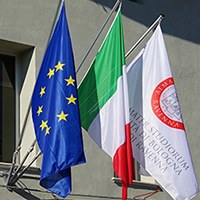
The first decentralized secretariat in the history of Bologna University opened at Ravenna on 3 November 1986; 1988 saw the foundation of the special-purpose School for Archivists; and in 1989 the first academic year of Environmental Science got under way at the Casa Matha Main Hall (Aula Magna). Out of these beginnings grew the deep bond that was to link the city of Ravenna to the University of Bologna in the years of the Ninth Centenary. The celebrations for those nine centuries of Bologna University coincided with a new start to decentralization in Romagna; and it was Ravenna that began, spurred by the formidable cultural and academic commitment shown in creating a Degree Programme and a University Faculty away from the mother city.
In 2001 the Ravenna Scientific and Teaching Centre was created as part of the Multicampus Project by Bologna University to spread its programme catalogue wider and set up stable research links across the territory.
As it broadened the range of its programme catalogue, the Ravenna outpost drew on local vocations: programmes with a history, like Conservation of the Cultural Heritage; a series of excavation sites in all corners of the globe; a Department, laboratories various and a degree programme in Environmental Science geared to protection of the habitat.
In recent years that catalogue has extended still further two degree programmes in Law, programmes in the health professions of Speech Therapy and Nursing, both under School of Medicine at Faenza, a degree in Building Engineering and degrees connected with Conservation and Restoring of Cultural Heritage artefacts a broad and varied spread, and an increasingly capillary representation of the University across the Region. In addition there is a degree programme at Faenza in Chemistry and Technology in relation to the Environment and materials, and a second-cycle Engineering degree in Building and Urban Systems, a second-cycle degree in Marine Biology as well as in Analysis and Management of the Environment.
As of academic year 2013/2014, a new Single-Cycle Degree Programme is being launched in Conservation and Restoration, which will replace the Degree in Techniques and Diagnostics for the Conservation and Restoration of Cultural Heritage Artefacts.
More recently, two other programs have been launched: the Second Cycle Degree/Two Year Master I-CONTACT (International Cooperation on Human Rights and Intercultural Heritage) in 2016 and the Single Cycle Degree/Combined Bachelor and Master in Medicine and Surgery (2020).
Paralleling this development, the Campus has boosted university services. Students now have study rooms, evening opening hours at the library, a welcome service, a Psychological Support Service, a University Language Centre, a Counselling Service with career guidance interviews towards more informed decision-making, laboratories for active work-related research, a Career Day, and opportunities of internships abroad.
A process of organizational change has involved the whole framework of the University (Multicampus decentralization, increased autonomy for teaching and research structures, integration of common services, reorganization of General Administration). As of 21 st December 2012, this ushered in the transition from Centre (Polo) to Campus.
Find out more
- The history of the University of Bologna Published
